Bloggers Beth Ginter & Emily Littleton
June 10, 2025

Members of the CCLC team (left to right) Jason Swope, Melissa Dombrowski, Stacie McGraw, Katie Pinkham, and Beth Ginter. Not pictured: Gabi Kinney.
Restoring the Chesapeake Bay is a big job. That’s why I’m honored to work alongside an incredible team. Thanks to them, we’ve reached a big milestone: We’ve just certified our 1,600th Chesapeake Bay Landscape Professional.
It’s why every member of our team is a superhero to me.
Like many superheroes though, they might be a little mysterious. So in this post, we invite you to get to know them better. It’s my pleasure to introduce (or reintroduce) each of them to you.
Our four regional coordinators lead stormwater management and green infrastructure training and outreach across the watershed:
- Melissa Dombrowski, Pennsylvania and Delaware
- Gabi Kinney, Virginia
- Stacie McGraw, Virginia
- Jason Swope, Maryland, DC, and West Virginia
Leading our fundraising, marketing, social media, fundraising, events, and administration (and keeping all of us in line!) is:
- Katie Pinkham, Programs and Engagement Manager
Read on to learn more about their individual superpowers and how they are advancing conservation landscaping to protect and restore the Chesapeake Bay. Thanks to Emily Littleton for helping us with these profiles.
-Beth
Melissa Dombrowski: Bringing Blue Green Infrastructure Across Pennsylvania and Delaware
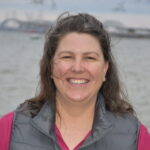 Melissa says she came to conservation landscaping “from the other end of the industry,” working for years in commercial turf management, garden center management, and landscape design. It was interesting, but she realized something was missing. Even with a horticulture degree, she was hungry to learn more about native plants and habitats. Volunteer work at the Surfrider Foundation introduced her to ocean and water conservation.
Melissa says she came to conservation landscaping “from the other end of the industry,” working for years in commercial turf management, garden center management, and landscape design. It was interesting, but she realized something was missing. Even with a horticulture degree, she was hungry to learn more about native plants and habitats. Volunteer work at the Surfrider Foundation introduced her to ocean and water conservation.
All those interests converged when she joined the team. She says, “Now it’s not ‘Let’s plant these five boxwoods in front of this house,’ but ‘Let’s find a better landscape design that can help keep pollutants out of the waterways, bring in native plants, and improve habitats.’”
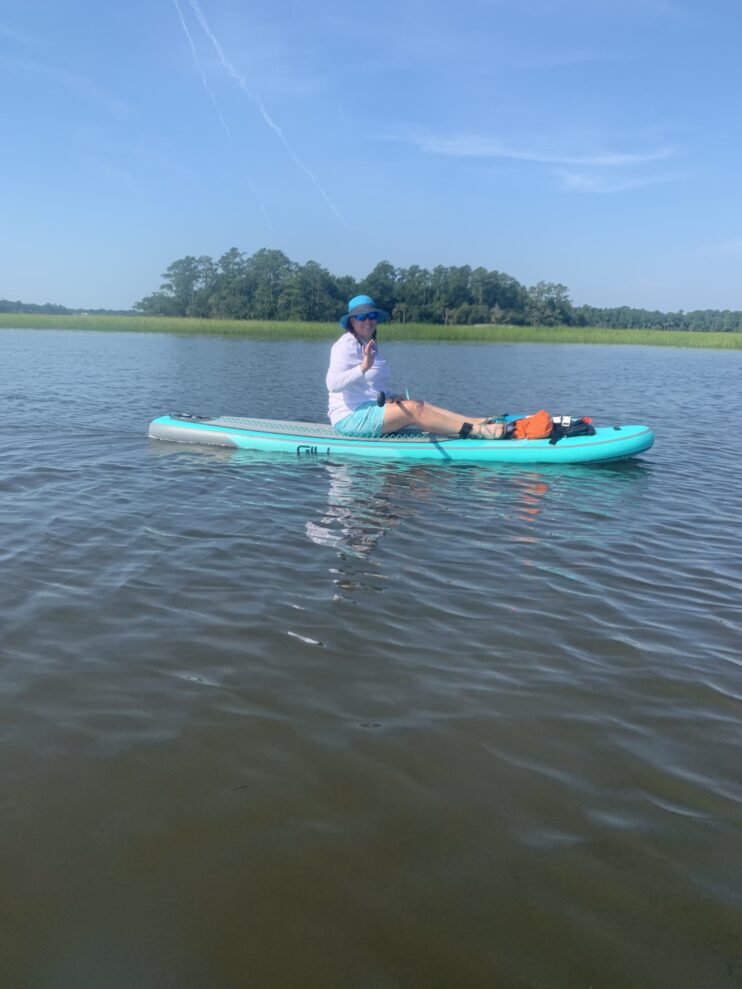
Melissa out enjoying a paddle. Her work with CCLC combines her interests in protecting waterways and supporting native plants and habitats.
As the regional coordinator for Delaware and Pennsylvania, Melissa is constantly communicating with professionals in the region who are interested in Chesapeake Bay Landscape Professional (CBLP) training, as well as with teammates and partner organizations.
Often she’ll be on the phone with landscape professionals who have completed their certification to discuss their projects. “As an organization, we want to help everyone get the training they need to get them where they want to go. But we don’t want people to take a class and just drop off the face of the earth. We want to stay involved in their education and careers and continue to help them make the whole Chesapeake Bay and beyond, better.”
Keeping people connected and working efficiently are among her driving forces. “I love improving processes, all around,” Melissa says. She’s known on the team for finding ways to make use of new technologies. She recently implemented task management software that helps the CCLC staff stay in constant communication about what has to be done and when.
She brings that same love of process improvements to her training. As part of CCLC’s classes, participants learn from projects done by certified professionals. She says, “It’s nice to see when an installation looks good and is working properly. But not all of them are perfect. You can learn a lot from the good, the bad, and the ugly. When something hasn’t gone well, it’s helpful to hear why something didn’t work, and what the certified pro did to fix it.”
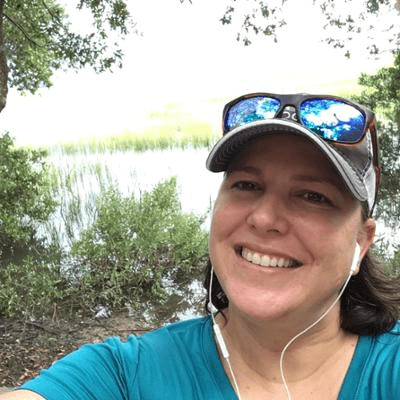
For Melissa, training is an opportunity to help professionals get the training they need and then support them as they bring their skills to the protection of the Bay.
In addition to her work with CLCC, Melissa also handles operations at a garden center. It gives her the chance to bring conservation landscaping expertise to people as they shop. “Some customers come in looking for specific plants, which they don’t realize are highly invasive and are illegal to sell in Delaware. It can be a big surprise to them why some plants have been restricted. But I can point them to better alternatives: natives that will do well in their yards and help the watershed too.”
Questions or want to learn more? Connect with Melissa on LinkedIn https://www.linkedin.com/in/melissa-dombrowski/
Gabi Kinney: Serving the Chesapeake Bay Watershed from Virginia’s Mountains to the Coast
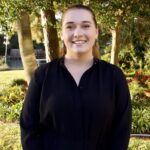 After working in environmental education and outreach, joining CCLC was a return to the fields and forests where Gabi Kinney feels most at home. “I love being outside and seeing how green infrastructure can be implemented in a way that not only addresses water quality but also provides recreation and beautification benefits for a community,” she says.
After working in environmental education and outreach, joining CCLC was a return to the fields and forests where Gabi Kinney feels most at home. “I love being outside and seeing how green infrastructure can be implemented in a way that not only addresses water quality but also provides recreation and beautification benefits for a community,” she says.
Water is part of her personal and professional life. A Certified Floodplain Manager with her degree in marine biology and master’s in natural resources and global sustainability, she worked for the U.S. Fish and Wildlife Service as a National Wildlife Refuge educator prior to her role with CCLC. She’s also a big paddler, kayaking in rivers and streams connected to the Bay and discovering unique places and “cool nature” as she does.
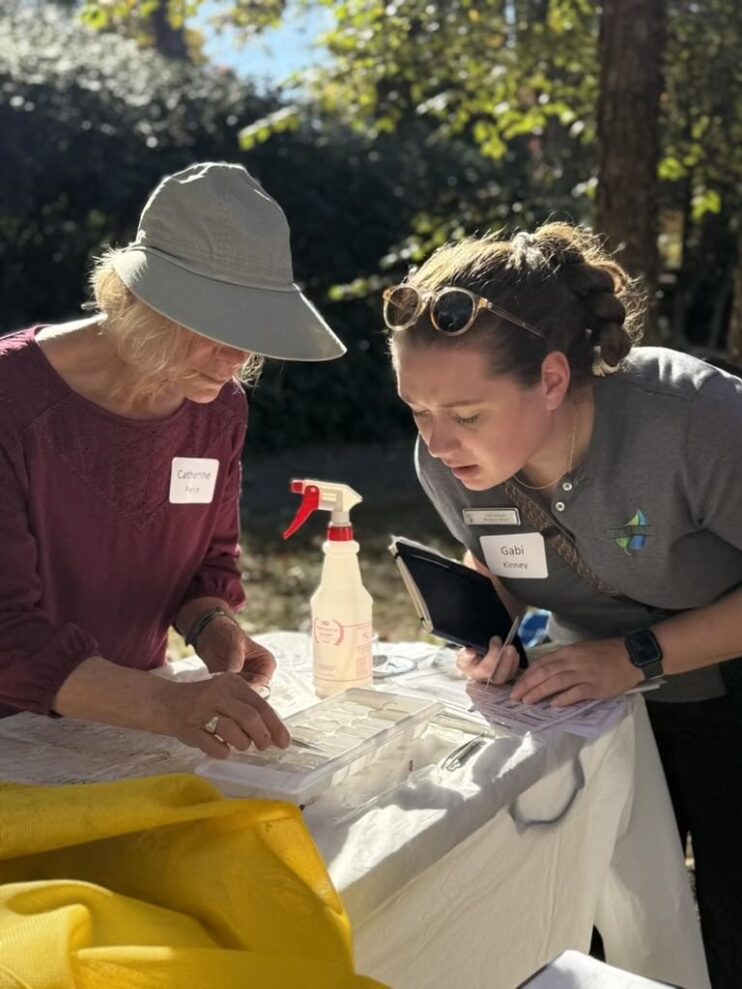
Gabi (right) examining stream samples at the 2024 James River Association Riparian Buffer Consortium Annual Meeting.
Her favorite projects are among the workforce of living shorelines and riparian buffers – waterside plantings that prevent erosion and filter stormwater before it enters the Bay or streams. She’s passionate about CCLC’s project that brings riparian buffer training to women at Virginia’s State Farm Correctional Center. With training, “Once the women return to the workforce, they have field skills and a certificate under their belt to help them launch careers in forestry, stormwater, or related industries,” she notes.
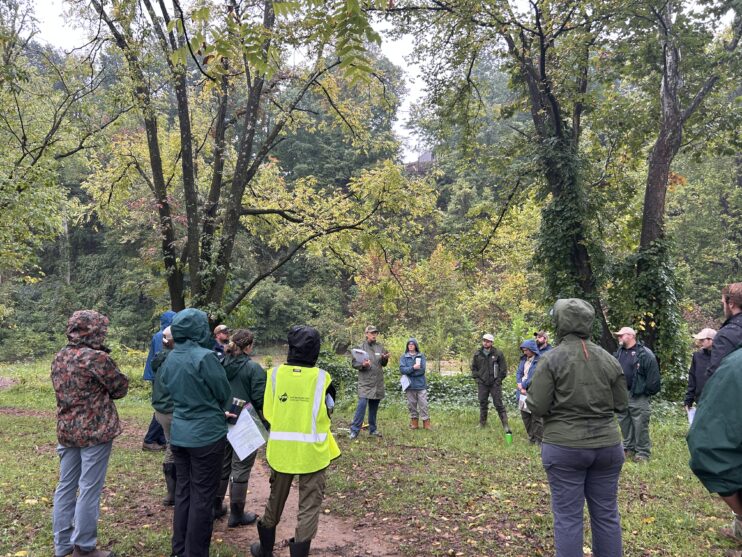
Participants and fellow instructors in Gabi’s first CBLP Buffers training. For Gabi, training focused on living shorelines and riparian buffers are among her favorite projects
Through a special organizational partnership, Gabi works part time for CCLC and part time for the nonprofit Wetlands Watch. Wetlands Watch, one of CBLP’s founding consortium partners, is a nonprofit focused on climate adaptation at the local level across Virginia. It gives her the opportunity to share each organization’s mission with an even wider audience. She says, “It’s my favorite part: I get to wear both hats in my CBLP training and contextualize the training with the broader flood work Wetlands Watch is doing.”
Among her duties for Wetlands Watch, she provides flood risk technical assistance to communities in the mountains of Virginia. She’s sensitive to how those areas are affected by increasingly intense, frequent, and long duration storms. She’s witnessed the impact of major flooding on the towns she grew up in and around Vermont.
In these rural areas, she’s helping to promote and build capacity for the special role western communities play in the Chesapeake Bay watershed. She notes, “People often don’t realize how far these rivers trek across the watershed and how deep in the state the rivers begin. Also, how differently stormwater is managed in urban areas compared to agricultural or rural valley communities. We’re building awareness of upstream and downstream effects to support a network of collaboration for the whole ecosystem.”
She believes values-based decision making is an important part of successful green infrastructure: “People operate in the ways they do because of their own passions, upbringing, and culture. Knowing the value that humans get from nature-based practices in their communities, helps me educate them about why it’s important to care for them.” She has found that people will become better stewards when caring for a practice that has meaning for them. “They’ll be more inclined to maintain a practice if it’s connected to something they care about, like having beautiful riverside habitat to paddle, swim, or fish in. It’s the butterfly effect.”
Questions or want to learn more? Follow Gabi on LinkedIn at https://www.linkedin.com/in/gabikinney06/
Stacie McGraw: Building Green Capacity and Understanding Across Virginia
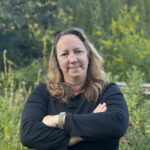
While working with homeowners as a Master Gardener, Stacie “really caught the bug of gardens as social change.”
With an educational background in horticulture and years tending her own plants, she sees conservation landscaping as something that almost anybody can do to make a significant difference. “Often when we talk about conservation and the environment, the problems seem so big and intimidating that people just don’t feel like what they can do is even a drop in the bucket. This is something that they can do that is the whole bucket. Because right there on their property, whatever size it is, they can do something and almost immediately start seeing insects and birds use it,” she says.
Like Gabi, Stacie works with CCLC as part of her work with Wetlands Watch, a nonprofit advancing climate adaptation in the state. The partnership allows both organizations to have an expanded reach into different communities.
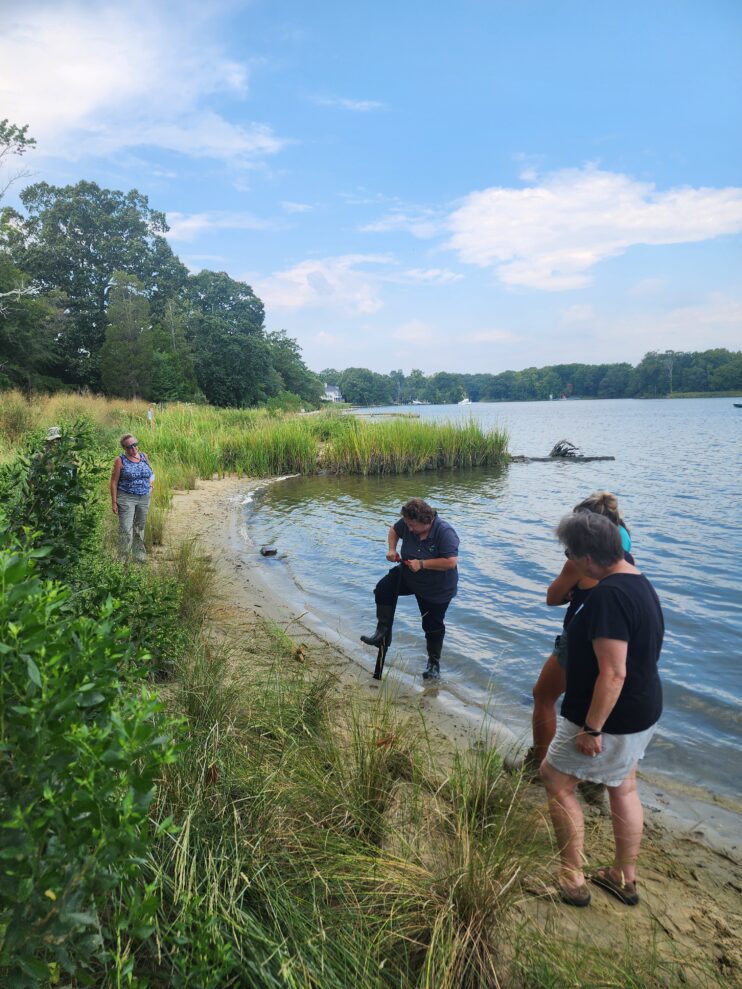
Stacie demonstrating planting techniques during a CBLP Living Shorelines training
She has a special place in her heart for the Chesapeake Bay Landscape Professional Associates (CBLP-A) program. The certification gives those with little experience in green infrastructure and conservation landscaping skills that they can use to find work and improve the environment. Over the course of just a couple weeks, participants have experiences they may never have had before. She says, “You can see the switches engage and all of this start to click together for them. Then when you see they applied for a summer internship or got a job doing this, you know it’s making a real difference for them, not just for the environment.”
Training often brings together the different teams who are designing, installing, and maintaining stormwater best management practices. While each team has a special role in ensuring a practice’s long term success, they don’t always connect with each other. For Stacie, fostering those connections during training empowers everyone to create longer lasting installations. For example, a landscape crew could explain to a bioswale designer why the angle of a property or the available clearance made their design very hard (or almost impossible) to maintain.
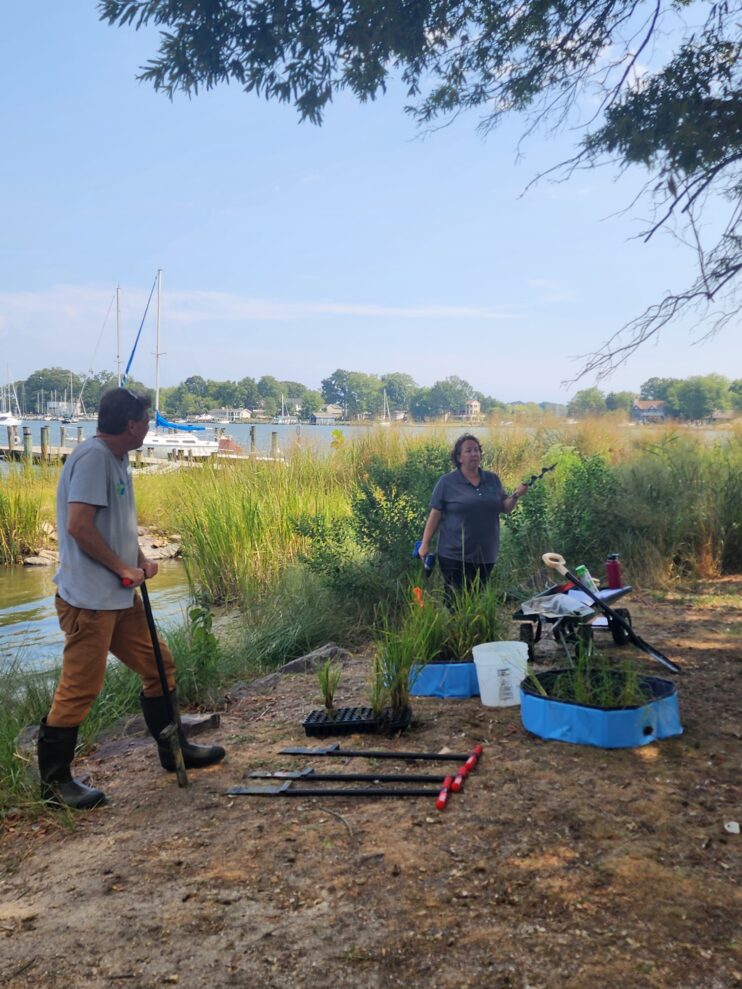
Stacie teaching a class about creating living shorelines, which can create natural habitats and help filter stormwater before it reaches the Bay.
She hopes more people discover that you can create conservation landscaping designs for whatever look you want on your property. “Thoughtful selection of plants and good design is what makes a garden aesthetically pleasing. If you want a more manicured look like what your neighbors have or that fits with certain norms, that is achievable. If you want a more wild and natural look at the back of your property, that’s possible too,” she notes.
Her biggest hope for the Bay is that taking care of it becomes normalized. She is looking forward to the time when all conversations can start with a common understanding of the importance of the Bay and the impact that we have on its health.
Questions or want to learn more? Follow Stacie at https://www.linkedin.com/in/stacie-mcgraw-1b315b87/
Jason Swope: Making Connections for Landscape Professionals in Maryland, DC, and West Virginia
 After decades working in the professional landscape industry, Jason understands the challenges faced by commercial landscapers and landscape designers. It’s one of the reasons he finds his work so meaningful. “The most important part of my job is to be a resource for certified pros and those considering CBLP certification or other CBLP training programs,” he notes.
After decades working in the professional landscape industry, Jason understands the challenges faced by commercial landscapers and landscape designers. It’s one of the reasons he finds his work so meaningful. “The most important part of my job is to be a resource for certified pros and those considering CBLP certification or other CBLP training programs,” he notes.
Jason can offer field-tested solutions and connections to professionals looking to correctly install and maintain conservation landscapes and green stormwater infrastructure. He can also effectively make the case to professionals about how CBLP training can open up new business opportunities. Once certified, Chesapeake Bay Landscape Professionals are able to bid on more projects, help clients who are seeking solutions to manage stormwater, and provide clients with conservation landscapes that are more sustainable and have a positive impact on our environment.
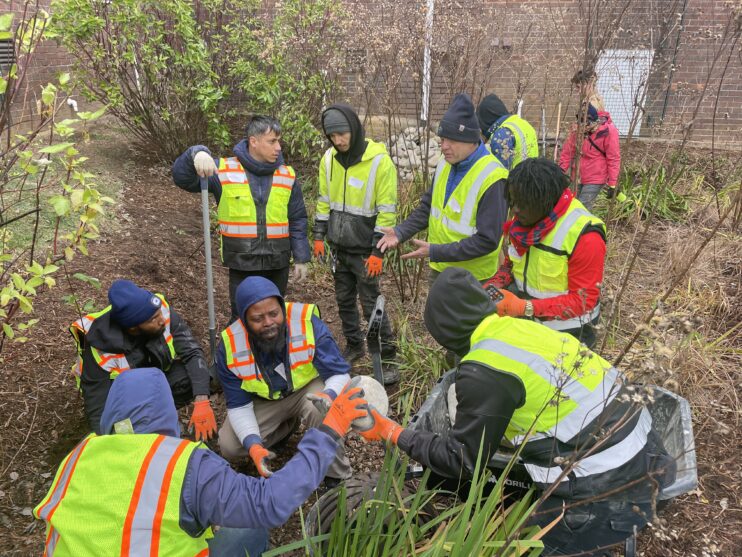
Jason (third from left, top row) working with a team working on a stormwater management best practice.
For Jason, his work “ties in elements of ecology, biology, chemistry, horticulture, and, when dealing with stormwater work, also connections to public spaces, different government regulations, and different personalities.” It’s an energizing mix that means he is always learning something new.
He’s seen all sides of the landscaping industry, from field work, to sales, to management. “The landscape industry isn’t always as ‘green’ as we think it is,” he says ruefully. Installing invasive plants, overuse of herbicides and pesticides, poor pruning practices, planting annual flowers in the same beds twice a year and replacing the plants that struggle and die with the same varieties – he found a lot of the practices are good from a sales perspective but not from a sustainable viewpoint.
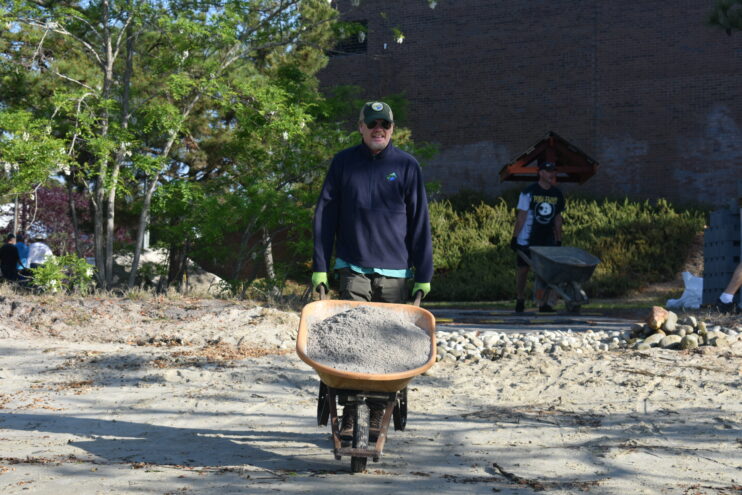
Jason at work building a better future for the Chesapeake Bay.
Working with CCLC gives him the chance to explore his interests and share his expertise in many areas.
- Learning about living shorelines and supporting CCLC’s living shorelines training gave him new insights into the tidal forces affecting waterfront properties and causing erosion.
- His background operating snowplows and managing snow removal contracts is particularly helpful to the State of Maryland’s “Smart Salting” program. As CCLC’s subject matter expert attached to the program, he advised contractors on the most environmentally sound ways to melt or remove snow.
- He also enjoys doing customized contractor training with maintenance crews at their worksites. He shares, “I know it is working because we have done training with crews and two weeks later they will send us pictures. They’ll let me know, ‘Hey we are doing that pruning you taught us about and it looks really good!’”
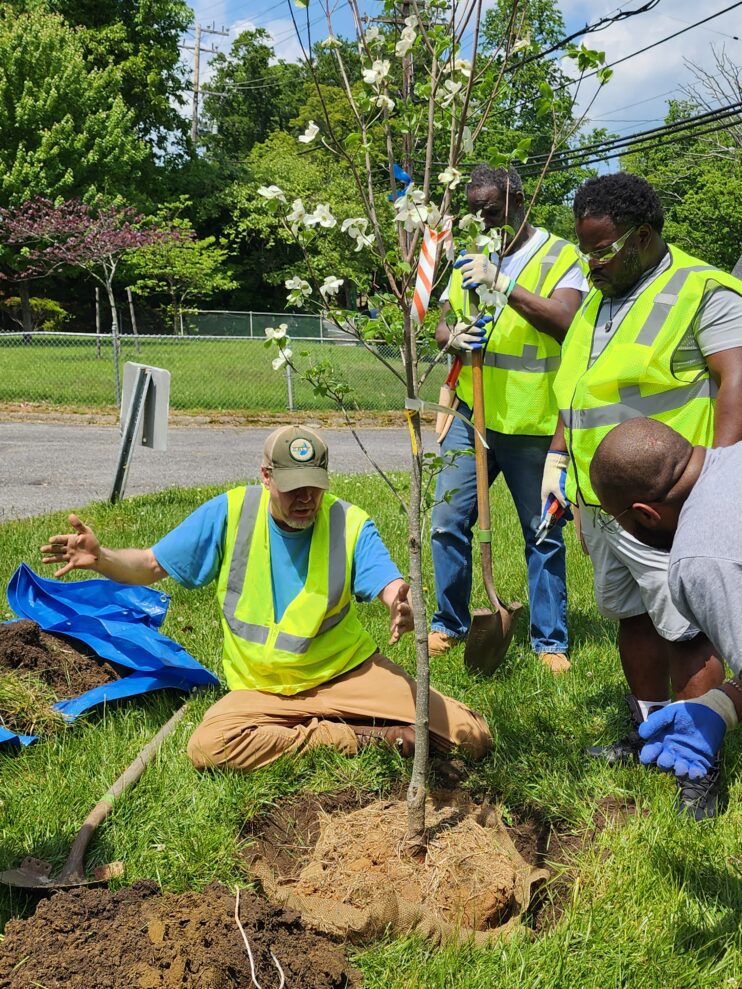
Jason working with crews at a customized contractor training, one of his favorite types of projects with CCLC.
Jason notes, “If someone had told me about conservation landscaping 25 years ago, when I first started in landscaping, I would have taken an entirely different path. My hope for the future, and I think it will happen, is we will see a shift when conventional landscaping practices are no longer the norm. Conservation practices will become the norm.” He adds, “It’s slowly happening over time. It’s really about education and outreach and helping landscape professionals realize there is another way to manage our landscapes, and it is a much more positive way.”
Questions or want to learn more? Connect with Jason on LinkedIn at https://www.linkedin.com/in/jasonswope/
Katie Pinkham: Spreading the Word about Green Stormwater Infrastructure

If you’ve heard of CCLC and its CBLP training, you have Katie Pinkham to thank.
As programs and engagement manager, she takes the lead on marketing and social media. Katie also heads up fundraising, manages registration for training sessions and attends to ensure they run smoothly, helps plan the “Turning a New Leaf” conference, and manages the organization’s administration and operations.
It’s work that draws heavily on her arts background and gives her the chance to stretch those skills. She earned her degree in fashion merchandising so she could use her creativity “to make people feel their best and experience the world in really beautiful awesome ways to the best of their abilities.” She uses that same inventiveness and caring at CCLC.
“I really like what we do. It’s really easy to become passionate about it. I wanted that thing that was doing something good for someone: not building a corporation but helping people,” she notes.
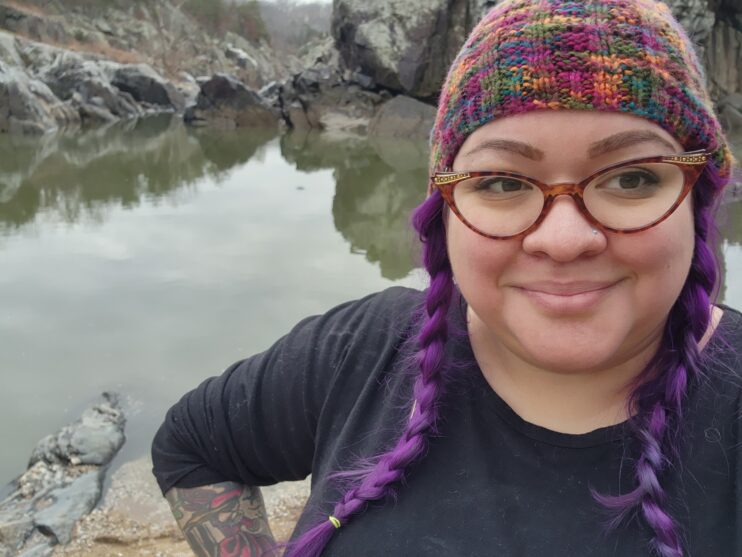
Katie is focused on keeping waterways clean.
She’s the ultimate connector for the organization. Every day, she’s answering questions about training, connecting certified professionals with each other, or helping certified professionals stumped by a current project reach their former CCLC instructors for guidance.
After the fierce competitiveness of the fashion world, the level of openness and collaboration within the Bay community surprised her. She says, “I remember being at a training early on, when contractors were freely sharing information about how they price things or where they got their products. That would never have happened in my old life. Everyone in this space is just trying to work toward better shared goals.”
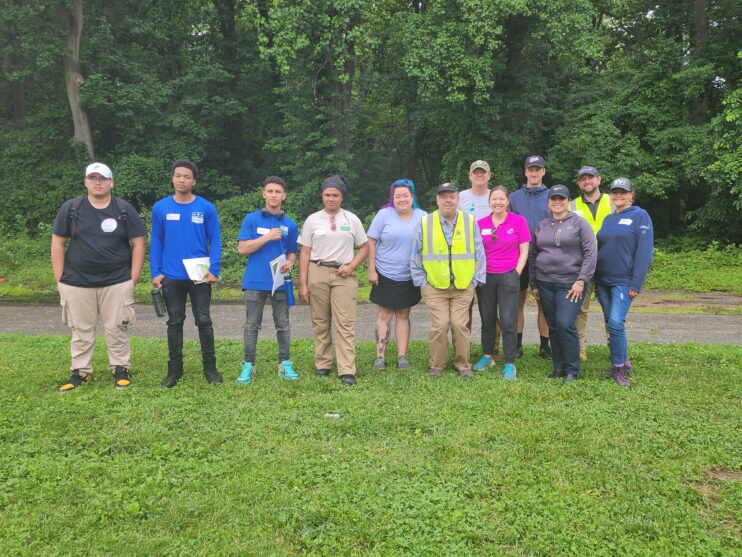
Katie (fifth from left) along with CCLC colleague Jason Swope (seventh from left) and participants in a CBLP-Crews training. Katie notes that maintenance of installations is key to their long term success.
Working with maintenance teams in the CBLP-Crews training is particularly rewarding. Often these crews are expected to maintain green infrastructure in a certain way but not told why. “But there’s this cool lightbulb moment in training, when they start to get it. They understand what that weird hole in the ground is doing and why. And how that work connects with their other interests, like fishing, and making sure that we still have fish or crabs in the future,” she says.

Katie at a rainy Level 1 training. You can follow her work spreading the news about Bay restoration and training opportunities on the official CCLC social channels.
Katie leads CCLC’s “Riparian Buffer Month” every October, planning training, outreach, special events, and more. “I’m nerdy about buffers,” she laughs. The month-long event and CCLC’s Riparian Buffer training are opportunities to help develop a new workforce, particularly in Pennsylvania, where she notes so many streams can still be buffered.
Thinking about her children’s future brings it all home. Seeing her kids swimming in the Bay by the tiny Chesapeake town where her grandfather once lived, marveling at a jellyfish, or exploring a creek by their home to find different rocks with “something particularly slimy or crawly to show me,” makes it “extra important to have a clean environment.”
Questions or want to learn more? Follow Katie’s work on the official CCLC socials facebook.com/ChesapeakeCLC, instagram.com/ChesapeakeCLC , and linkedin.com/company/chesapeake-conservation-landscaping-council
 Beth Ginter is the first Executive Director of the Chesapeake Conservation Landscaping Council. Additionally, she oversees the Chesapeake Bay Landscape Professional (CBLP) program, a certification effort which provides consistent training and practice standards for landscape professionals working in the Chesapeake Bay region, Ms. Ginter has a Masters degree in Sustainable Landscape Design from The George Washington University. Her limited free time is spent with her family, walking her corgi, and catching up on her reading.
Beth Ginter is the first Executive Director of the Chesapeake Conservation Landscaping Council. Additionally, she oversees the Chesapeake Bay Landscape Professional (CBLP) program, a certification effort which provides consistent training and practice standards for landscape professionals working in the Chesapeake Bay region, Ms. Ginter has a Masters degree in Sustainable Landscape Design from The George Washington University. Her limited free time is spent with her family, walking her corgi, and catching up on her reading.
 Emily Littleton is a freelance writer and advocate for clean water for everyone. After decades as a communications leader at National Public Radio (NPR), she is being certified as a Master Watershed Steward and finding new ways to support the streams and rivers that feed the Chesapeake Bay.
Emily Littleton is a freelance writer and advocate for clean water for everyone. After decades as a communications leader at National Public Radio (NPR), she is being certified as a Master Watershed Steward and finding new ways to support the streams and rivers that feed the Chesapeake Bay.


